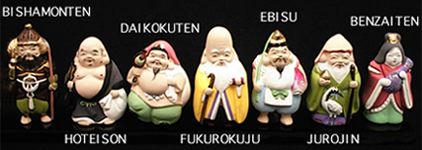ANNUAL CALENDAR January |
|
Paying your respects to the Seven Deities of Good Fortune
|
|
During New Year, people young and old can be seen visiting several temples and shrines in a single neighborhood. They are paying their respects to the Shichifukujin (the Seven Deities of Good Fortune) to pray for successful business or safety for the family.
The Seven Deities of Good Fortune are a curious assortment of gods and saints originating in three countries and three religions (Buddhism, Taoism, and Shinto) and are said to bring happiness, wealth, and longevity. 
Most shrines and temples associated with the Shichifukujin are dedicated to just one of the gods, so that seven temples and shrines in one neighborhood form one group. But in some cases two gods are worshiped in one place, or sometimes even all seven of them. There are said to be more than 100 such groups of temples and shrines throughout Japan. From January 1, the icons of these gods are unveiled to the public. The length of the period during which visitors can view the icons vary widely depending on the group; it commonly lasts until January 3, 7, 15, 20, or 31. In Tokyo there are over 20 groups of shrines and temples dedicated to the seven deities. The most popular of these are the Sumida River Shichifukujin, which have hosted these visits since the Edo period (1603-1868). Between January 1 and 7 each year, a total of about 100,000 people visit the Mimeguri Shrine, the starting point of this course. The Yanaka Shichifukujin, the oldest group in Tokyo, welcome visitors until January 15, and about 30,000 people make the pilgrimage every year.
Photo: Small, simplified figurines of the seven gods can be bought in gift shops. There are regional variations as to what each god represents and what they look like. |
APR | MAY | JUN | JUL | AUG | SEP | OCT | NOV | DEC | JAN | FEB | MAR |
 |